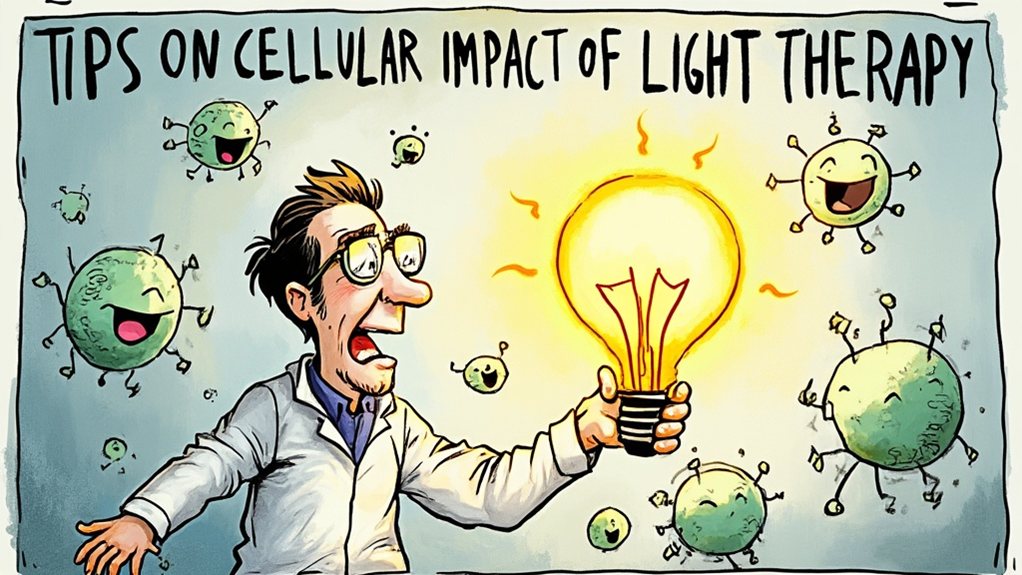Light therapy boosts your cellular health by optimizing mitochondrial function, increasing ATP production for energy. It also helps manage reactive oxygen species (ROS), which play an essential role in cellular repair. Additionally, light stimulation improves intercellular communication, facilitating better signaling and recovery processes. By incorporating light therapy into your routine, you can promote resilience and healing in your cells. Discover how these elements work together for your well-being as you investigate further insights.
Key Takeaways
- Light therapy boosts mitochondrial function, increasing ATP production for enhanced energy and cellular repair processes.
- Different wavelengths of light, especially red and near-infrared, optimize intercellular signaling and communication.
- Photons from light therapy stimulate the release of signaling molecules, improving blood flow and overall cellular health.
- Light therapy aids in balancing reactive oxygen species, supporting the body's natural repair mechanisms.
- Regular use of light therapy fosters resilience in cells, promoting recovery and vitality throughout the body.
Understanding Mitochondrial Function and ATP Production
Understanding mitochondrial function and ATP production is fundamental for grasping how light therapy influences cellular processes. Mitochondrial dynamics play a significant role in maintaining energy homeostasis within your cells. These organelles continuously undergo fission and fusion, adapting their structure and function to meet cellular energy demands. When you engage in light therapy, it stimulates ATP synthesis, enhancing your cells' energy output. This increased ATP availability supports important cellular functions, including growth, repair, and metabolic regulation. By optimizing mitochondrial function, your cells become more resilient, promoting health and well-being. Embracing light therapy can be a transformative experience, allowing you to harness the power of your mitochondria and boost your cellular vitality. By understanding these processes, you'll feel more connected to your body's inner workings.
The Role of Reactive Oxygen Species in Cellular Repair
While often perceived as harmful, reactive oxygen species (ROS) play an important role in cellular repair mechanisms. When you experience oxidative stress, your cells generate ROS as a byproduct. Surprisingly, these molecules can act as signaling agents, facilitating communication within your cells. They help activate repair pathways, promoting healing and regeneration. By modulating cellular signaling, ROS can influence processes like apoptosis and inflammation, ensuring your body responds appropriately to damage. This delicate balance between ROS production and elimination is vital; too much can lead to further damage, while the right amount fosters recovery. Understanding ROS's dual role empowers you to appreciate their contribution to cellular health and resilience during light therapy and other healing modalities.
Enhancing Cellular Communication Through Light Stimulation
As you investigate the effects of light stimulation on cellular communication, you'll find that photons can greatly augment intercellular signaling. Different light wavelengths interact with cells in unique ways, promoting improved cell signaling and facilitating better communication among them. For instance, red and near-infrared light wavelengths penetrate tissues effectively, boosting mitochondrial activity and subsequently increasing ATP production. This energy surge supports the release of signaling molecules, which enhances cellular interactions. Furthermore, light therapy can modulate factors like nitric oxide, further improving blood flow and nutrient delivery. By harnessing these benefits, you can optimize cellular communication, leading to improved healing and overall cellular function. Embracing light therapy could be a game-changer for your cellular health journey.
Frequently Asked Questions
How Long Does a Light Therapy Session Typically Last?
A light therapy session typically lasts 15 to 30 minutes, depending on your specific needs. For ideal timing, you should aim to schedule sessions consistently to maximize benefits and improve your experience.
Can Light Therapy Be Used on All Skin Types?
You might worry about compatibility, but light therapy works well on all skin types. Different light wavelengths suit various conditions, ensuring you can benefit from its effects regardless of your skin's unique characteristics.
Are There Any Side Effects of Light Therapy?
While light therapy is generally safe, some might experience mild side effects like redness, irritation, or headaches. It's important to monitor your skin's response and consult a professional if any concerns emerge.
How Frequently Should Light Therapy Be Administered for Best Results?
For ideal treatment, you should follow frequency recommendations. Typically, sessions are scheduled several times a week initially, then adjusted based on your response. Consistency is key for achieving the best results using light therapy.
Is Light Therapy Safe for Children and Pregnant Women?
While light therapy offers numerous benefits, it's wise to follow safety guidelines for children and pregnant women. Always consult a healthcare professional to guarantee a gentle and appropriate approach for these vulnerable groups.
Conclusion
Incorporating light therapy into your routine can be like tuning a musical instrument; it fine-tunes your cells for peak performance. Just as a guitar needs the right tension to produce harmonious sounds, your cells rely on boosted mitochondrial function and reactive oxygen species to thrive. By embracing light therapy, you're not just illuminating your body—you're energizing your very core, paving the way for improved cellular communication and repair, ultimately leading to a healthier, more vibrant you.
